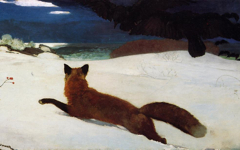Homer’s Briarwood Pipe (1864)
This painting, The Briarwood Pipe by Winslow Homer, seems to depict a scene early in the American Civil War. Currently exhibited in New York's Metropolitan Museum as part of an exhibition on the Civil War, it was painted in 1864, the year before the war ended. It must have been based on sketches from a few years earlier.

Homer, The Briarwood Pipe (1864) Oil on canvas. 43 x 38 cm. Cleveland Museum of Art, Ohio.
Click image to enlarge.
The colorful uniforms, worn by these Yankee soldiers known as Zouaves, were too easily spotted by Confederate snipers and were quickly abandoned after the War started.1 Besides this cannot be an illustration, as many believe, because it was painted by an artist by which I mean a poetic painter. There must be something else going on....and there is.
Click next thumbnail to continue
The first clue, not noted before, is that Homer's signature in the lower corner is crowned by laurel, perhaps even identifying with his Greek namesake. Homer is a poet and he knows it.
Click next thumbnail to continue
Turning to the main image we see that the soldier on the left is deeply involved in carving a pipe out of wood, his concentration on his craft matched, no doubt, by Homer on his. He is an alter ego of the artist. The proof, furthermore, is in the leg of his pantaloon, the fabric of which forms Homer's own face in profile. The soldier thus emerges from Homer's head.2
Click next thumbnail to continue

Left: Detail of Homer's The Briarwood Pipe
Center: Detail of a photograph of Homer in 1863. National Portrait Gallery, Washington DC.
Right: Diagram of the detail showing Homer's face in the fabric.
Click image to enlarge.
Take a look at a photograph of Homer from the year before (center). His nose ends in a protruberance very similar to that indicated in the fabric and with a large nostril as well. His "upper lip" is broad though it suggests, perhaps, the outward bulge of his moustache. There is definitely a "mouth".
Click next thumbnail to continue
Behind the soldiers a blanket or perhaps tent canvas, hangs vertically over a pole like an artist's canvas pinned to a wooden frame.3 Meanwhile the large tassle on the Zouave's kepi in front of that "canvas" suggests the hairs of a golden "paintbrush". He smokes a pipe as a metaphor for the artist's imagination while concentrating like his friend on the making of the other pipe.
See conclusion below
The subject here, as so often in art, is imagination and craft. It is a scene of the artist's alter ego, both of them, in the process of conceiving and making The Briarwood Pipe, the painting itself.
More Works by Homer
Notes:
1. The Confederates had Zouaves as well.
2. This type of veiled "self-portrait" has rarely, if ever, been recognized by academic art historians even though, as I show on this site, it is a very common feature of significant art. I have revealed it in works by Dürer, Rubens, Rembrandt, Van Gogh, Lord Leighton, Pierre Bonnard, Balthus and Francis Bacon. I will soon show something very similar too in Van Dyck's Self-portrait with a Sunflower.
3. The outline of the two principal tents may even form an upside-down W for Winslow, a very common but little-known technique in art. Homer could have seen it in masterpieces and engravings of masterpieces almost anywhere. Many examples are listed inder the theme Letters in Art.
Original Publication Date on EPPH: 02 Jun 2013. © Simon Abrahams. Articles on this site are the copyright of Simon Abrahams. To use copyrighted material in print or other media for purposes beyond 'fair use', you must obtain permission from the copyright owner. Websites may link to this page without permission (please do) but may not reproduce the material on their own site without crediting Simon Abrahams and EPPH.





